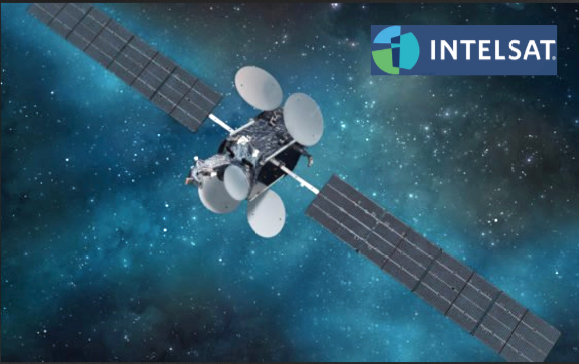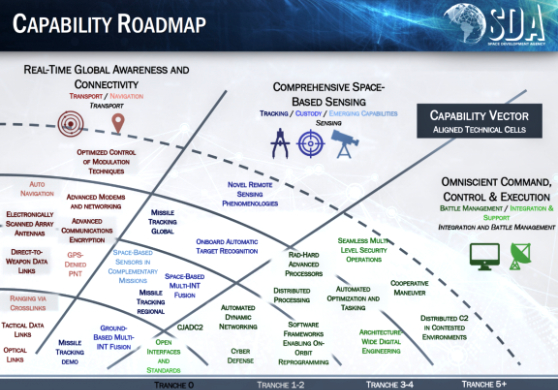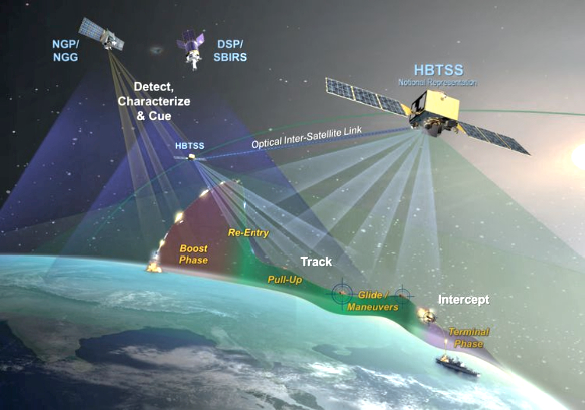Intelsat, OneWeb + Linchpin Solutions Demo Global, Multi-Orbit Satellite Service to U.S. Army + U.S.
DoD Intelsat, OneWeb (OWT) and Linchpin Solutions have successfully demonstrated a multi-orbit satellite communications solution for representatives of the U.S. Army and Department of Defense (DoD).

This is a strategic demonstration to the U.S. DoD that shows transport diversification between GEO and LEO constellations, with seamless switching between them.
Referred to as Automated Primary, Alternate, Contingency, and Emergency (APACE) communications, the solution enables soldiers to survive and excel in contested electronic warfare environments. The reliability of communications is significantly improved by simultaneously sending data over multiple paths and adjusting the traffic flow in real-time between GEO and LEO satellite constellations.

Intelsat and OWT used both GEO and LEO services simultaneously, switching the data flow between orbits instantly at the packet level, using software to determine which connection will provide the best experience based on the technical requirements of the end service. The software solution can be hosted on existing fielded ruggedized virtual machine platforms allowing the system to run in the harshest environments.
Two satellite links were established during the demo – one on the Intelsat 37 (IS-37) satellite and one on a OneWeb satellite. The links communicated through various end- user terminals, including a SatCube terminal, a Kymeta U7/8 terminal, a Litecom GEO terminal, and a OneWeb Intellian terminal, demonstrating applications such as two-way voice and data downloads and MP4 video.

Intelsat’s FlexMove service, combined with partner terminals, can be deployed within an hour. For military customers, this quick set-up, reliable and secure offering provides Beyond-Line-Of-Sight (BLOS) seamless communications at times when connectivity is most critical.
“This demonstration shows how through the power of partnership, we can provide a reliable, secure, multi-orbit, multi-band capability for the military that connects our warfighters to meet their evolving mission requirements,” said President of Intelsat General, Dave Micha. “This enables the delivery of required connectivity, throughput and services to customers when and where that reliable access is needed, even in the harshest elements.”
“This demonstration of low latency, high-capacity throughput via a multi-orbit solution that increases the resiliency of commercial SATCOM to DoD and allied partners globally is an important steppingstone as OneWeb rises to the challenges and needs of our customers through partnerships,” said Bob Roe, CEO of OneWeb Technologies, the U.S. Proxy subsidiary of OneWeb.
Demo’ing SAR OISL Capability With The SDA’s National Defense Space Architecture Is Capella Space
Capella Space has announced that the company will become the first commercial synthetic aperture radar (SAR) supplier to demonstrate Optical Inter- Satellite Link (OISL) compatibility with the U.S. Space Development Agency (SDA)’s new National Defense Space Architecture (NDSA).

SAR data is a highly valuable asset for the SDA and the U.S. Department of Defense. The next generation of Capella’s persistent SAR monitoring capabilities will leverage new technology that enables high delivery speeds and direct access to its 24/7 all-weather data for U.S. Government customers.
Capella Space will install optical communications terminals (OCTs) on its commercial SAR satellites, starting in late 2022. This will enable the company to use highly efficient laser communications technology to send and receive data to and from its satellites in LEO, relaying data to compatibly equipped government satellites and military operations on the ground. The integration of OCTs onto Capella’s SAR constellation will drastically reduce latency from image collect to download and ensure spaceborne data is quickly available to inform critical decision-making for terrestrial missions.
Capella Space selected Mynaric’s CONDOR Mk3 Optical Communications Terminal. The company selected Mynaric’s technology following a thorough vetting process. Mynaric has previously demonstrated compatibility with the SDA systems and standards.

Capella Space has partnered with a number of U.S. Department of Defense agencies, including the National Reconnaissance Office (NRO) , U.S. Air Force, U.S. Army and the U.S. Space Force.
This announcement follows a new Collaborative Research Agreement with the U.S. Army Space and Missile Technical Defense Center as well as the hiring of Amy Hopkins as Capella’s new vice president and general manager of U.S. Government. Since officially launching commercial operations in January 2021, Capella’s new innovations and the growth of its federal team positions it to serve U.S. Government customers with fast, direct access to reliable SAR data in order to solve challenges from tactical users to global policy making.
In 2016, Capella Space was founded to enable a richer understanding of our planet in entirely new and powerful ways. The company saw an opportunity to use SAR to monitor the Earth, including the 75% that is either covered in the darkness of night or obscured by clouds.
“Our team at Capella Space is thrilled to become the first commercial SAR company to demonstrate compatibility with the SDA’s National Defense Space Architecture and standards,” said Christian Lenz, CTO at Capella Space. “Enabling our satellites to integrate with the new SDA architecture efficiently is a critical step for us to work seamlessly with the U.S. defense and intelligence sector. We are proud to be able to work with the SDA in demonstrating this cutting-edge technology.”
“We are honored to be selected as the optical communications terminal vendor for Capella Space’s integration work with the SDA. The announcement today highlights the importance of standardization and compatibility within the industry,” said Bulent Altan, CEO of Mynaric, “Our recently announced CONDOR Mk3 is fully compliant to the SDA’s interoperability standard and a natural match for Capella’s innovative approach integrating commercial capabilities with governmental customers.”
Geospatial Intelligence Community Should Leverage More Commercial Technology
National Geospatial-Intelligence Agency (NGA) Director Vice Adm. Robert Sharp, in his role as the GEOINT Functional Manager, recently published the National System for Geospatial Intelligence Enterprise Commercial GEOINT Strategy 2021-2025, calling on the GEOINT community to leverage more commercial technologies and methods to help the enterprise move faster and grow stronger.

“By taking a community approach to commercial GEOINT – one that aligns with our overarching NSG strategic goals, we continue to pave a way forward that not only benefits and supports our global national security needs but expands our partnerships within the growing sector of commercial GEOINT – giving access to responsive and innovative tools and capabilities that will help us meet the challenges of the 21st century and beyond,” Sharp said.
The NSG is the combination of technology, policies, capabilities, doctrine, activities, people, data and communities necessary to produce GEOINT in an integrated multi-intelligence, multi-domain environment. The strategy sets a variety of initiatives in four different areas: Drive unity of effort Diversify sources and build capacity through partnerships Improve data security and develop processes to mitigate risks Influence and foster commercial capabilities Multiple other U.S. strategies – the National Strategy for Space, National Defense Strategy and Defense Space Strategy – played a key role in developing this strategy because of their references to the criticality of strengthening and leveraging private sector innovation for national security. Deliberate industry engagement that is well-planned and interoperable across our enterprise will generate synergy across the NSG.
Seeking To Shape NATO’s Future Surveillance + Control Are Northrop Grumman + Airbus Northrop Grumman Corporation (NYSE: NOC) and Airbus Defence and Space, together with seven industrial players, have established ASPAARO, the Atlantic Strategic Partnership for Advanced All- domain Resilient Operations. ASPAARO will bid to undertake the Risk Reduction and Feasibility Studies (RRFS) for the NATO Support and Procurement Agency as part of the Alliance Future Surveillance and Control (AFSC) program.
The feasibility studies are a key milestone in the AFSC program which aims to support NATO and NATO nations as they consider the Alliance’s future tactical surveillance, command and control capabilities after the current Airborne Warning and Control System (AWACS) fleet reaches the end of its service life in 2035.
Following the delivery of a High-level Technical Concept in 2020 by three of the team members (Airbus, Lockheed Martin and MDA Ltd.), Airbus continues to support NATO in the concept stage of the AFSC program together with Northrop Grumman and a strong transatlantic team including Lockheed Martin (US), BAE Systems (UK), KONGSBERG (Norway), MDA (Canada), GMV (Spain), Exence (Poland) and IBM (US).
ASPAARO offers an unparalleled set of skills and capabilities that will address the threats of today and tomorrow and will fulfill the Alliance’s requirements across all domains. The industry team will leverage its multi-domain concepts, advanced technologies and integrated designs to pave the way to a fully interoperable architecture between NATO nations while further driving innovation through combined access, investments and experience.
Seeking To Shape NATO’s Future Surveillance + Control Are Northrop Grumman + Airbus
Northrop Grumman Corporation (NYSE: NOC) and Airbus Defence and Space, together with seven industrial players, have established ASPAARO, the Atlantic Strategic Partnership for Advanced All- domain Resilient Operations. ASPAARO will bid to undertake the Risk Reduction and Feasibility Studies (RRFS) for the NATO Support and Procurement Agency as part of the Alliance Future Surveillance and Control (AFSC) program.

The feasibility studies are a key milestone in the AFSC program which aims to support NATO and NATO nations as they consider the Alliance’s future tactical surveillance, command and control capabilities after the current Airborne Warning and Control System (AWACS) fleet reaches the end of its service life in 2035.
Following the delivery of a High-level Technical Concept in 2020 by three of the team members (Airbus, Lockheed Martin and MDA Ltd.), Airbus continues to support NATO in the concept stage of the AFSC program together
with Northrop Grumman and a strong transatlantic team including Lockheed Martin (US), BAE Systems (UK),
KONGSBERG (Norway), MDA (Canada), GMV (Spain), Exence (Poland) and IBM (US).
ASPAARO offers an unparalleled set of skills and capabilities that will address the threats of today and tomorrow and will fulfill the Alliance’s requirements across all domains. The industry team will leverage its multi-domain concepts, advanced technologies and integrated designs to pave the way to a fully interoperable architecture between NATO nations while further driving innovation through combined access, investments and experience.
Hypersonic + Ballistic Tracking Space Sensor CDR Completed By Northrop Grumman For The Missile Defense Agency
Northrop Grumman Corporation (NYSE: NOC) recently completed the critical design review (CDR) of the Hypersonic and Ballistic Tracking Space Sensor (HBTSS) prototype for the U.S. Missile Defense Agency (MDA).

The review establishes the company’s technical approach for precise, timely sensor coverage to defeat ballistic and hypersonic missiles. HBTSS satellites will provide continuous tracking and handoff to enable targeting of enemy missiles launched from land, sea or air.
They are a critical part of the Overhead Persistent Infrared (OPIR) multi-layered constellation of satellites, which can sense heat signatures to detect and track missiles from their earliest stages of launch through interception.
HBTSS satellites are also designed to track threats with near global reach when prompted by other OPIR systems, well before they come into view of U.S. ground- based defenses.
Northrop Grumman received a $153 million contract from the MDA earlier this year for the Phase IIB portion of the HBTSS program and is on schedule to deliver the HBTSS prototype in 2023. After the HBTSS prototype is delivered, the company will conduct an on-orbit test to demonstrate its ability to continuously track and rapidly process its observations of hypersonic threats, as well as its ability to effectively hand off the information so the missile is intercepted.



